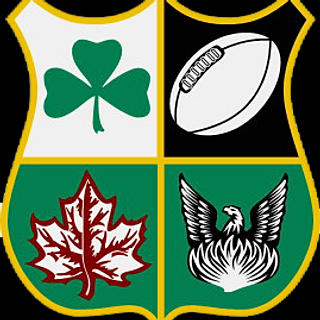Military Influence on Rugby in Canada
- BOD
- Nov 10, 2017
- 4 min read
In honour of Remembrance Day I thought it was appropriate to highlight some of the history that the military plays in Canadian Rugby. I've relied on the words and sources of others and tried my best to add the sources to the bottom of this article.
Canada was part of the British Empire for many years, so it is natural that British games took root in Canada. The most prominent is rugby. British settlers, garrison troops and members of the Royal Navy probably introduced the game to Canada from 1823 onwards and fostered its development in many parts of the country, especially in Halifax, Toronto, Montréal. Later in the 19th century, Vancouver, which, owing to its favourable climate and strong British tradition started to rise in popularity. F. Barlow Cumberland and Fred A. Bethune first codified the rules for rugby football in Canada in 1864 at Trinity College, Toronto. In 1868, the first club, the Montreal Football Club was formed. The first game in British Columbia was played in 1876, between members of the Royal Navy and the land forces on Vancouver Island. It was another ten years before the game was played on the mainland and in 1889; the British Columbia Rugby Union was formed.
World War 1
Across Canada, there was a brief pre-war resurgence of rugby, but that was soon dissolved with the advent of war. From 1914 to 1919, only in British Columbia and Nova Scotia, were there sufficient numbers of teams to arrange matches on a semi-regular basis. Elsewhere, most rugby was disbanded in favour of a more concerted war effort. There is evidence to support an active effort to keep rugby alive during the war years, to help keep morale up amongst servicemen and civilians. Rugby was one of several sporting activities encouraged by senior officers as a variation from the troops’ repetitious military training and drills. Rugby was played not only to maintain fitness but it also contributed towards team spirit within the military’s units. In wartime, rugby was approved therapy for shattered men from the front; it would now play a part in the entire nation’s recovery.

Nigel McCrery researched for two years combing sporting and military records to identify players who fought in the 'war to end all wars', which left almost 908,000 British and Commonwealth soldiers dead. Mr. McCrery found 140 players from nine international teams who died in battlefield. Most were from England, Wales, Scotland, Ireland, Australia, New Zealand or South Africa but some represented France and the USA. I could not find a listing for Canadian players.
Following the Armistice in November 1918, hundreds of thousands of servicemen from across the British Empire spent the early months of 1919 waiting for ships to return them home from England. During this time a rugby competition was arranged between the forces from New Zealand, Australia, South Africa, Canada, England (named Mother Country), and Royal Air Force. The 1919 Inter-Services tournament (also known as the King’s Cup tournament) was the first international rugby event involving several representative teams from the northern and southern hemispheres. The showpiece playoff was held at Twickenham on 16 April, but the men in black were too much for the home Mother Country team and won 9-3. As a final diplomatic coda, the French allies were invited over to play the winner, but fared no better, defeated by 20-3 by the New Zealanders.

After World War 1, there was a marked increase in rugby across Canada, as returning servicemen rejoined their old clubs. In 1919, a Canadian Services Team played overseas against representatives from England, New Zealand, South Africa and Australia. The formation of the Rugby Union of Canada took place in 1929 and this was followed by a tour of Japan by a Canadian representatives side in 1932 (W5, L2).
World War 2
During World War 2, Rugby participation followed a similar pattern all across Canada. It was played on a limited basis as most rugby players became too involved with the war effort to continue playing the game. The games that were played, mainly involved members of the Commonwealth Forces. In 1949, there were only three active Provincial Unions: British Columbia, Ontario and Quebec. Since 1945, Provincial Rugby Unions have experienced marked growth and the Rugby Union of Canada, which functioned for ten years before 1939, was reformed in 1965. The present administrative body, the Canadian Rugby Union, know as Rugby Canada, was incorporated in 1974.
Rugby and the Canadian Military Today
While there are players with different levels of experience throughout the country, only one base, CFB Petawawa, has a full team that plays in a senior men’s league in Ontario. On the international level, the Canadian Armed Forces Rush RFC compete at the International Defense Rugby Competition against other militaries around the world.

I also found an article in 2016 about Canadian forces participating in Operation REASSURANCE in Central and Eastern Europe put together a rugby team to compete against national teams from Poland and the Czech Republic. Rugby also has a proud history at Royal Military College of Canada with some of our very own club members graduating and playing for RMCC.
Sources (The above article are not my words. I relied on many sources to copy and paste and assemble this article.)
http://www.rugbyfootballhistory.com/rugbyatwar.html
http://www.rugbyfootballhistory.com/canada.html
http://www.dailymail.co.uk/news/article-2531055/Pictured-The-England-rugby-team-pose-photograph-just-months-called-fight-First-World-War-seven-perish.html
https://ww100.govt.nz/a-wartime-world-cup
https://www.thehistorypress.co.uk/articles/the-king-s-cup-1919/
http://www.forces.gc.ca/en/news/article.page?doc=we-contributed-to-something-larger-than-ourselves-latest-tour-of-the-operation-reassurance-land-task-force-draws-to-a-close/is4u8q4d








Comments